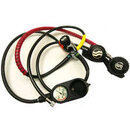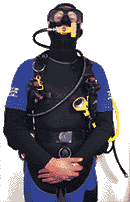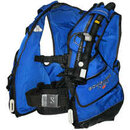DevonDiver
N/A
I'm starting this thread as an off-shoot to a current discussion on AIRII systems. Most of the debates about any singular AAS configuration seem to disintegrate into a 'my system is better than yours' arguement. For the sake of clarity, I thought it might be interesting to compare and contrast the percieved pros and cons of varied AAS configurations, in a logical and side-by-side manner.
I've included a poll, so that readers can get an understanding of the relative popularity of these configurations amongst the participants (not thinking for a moment that SB membership accurately represents the true state of the diving community as a whole).
So, to get the ball rolling, I am listing 3 major configuration alternatives, that encompass the primary methods used for air-sharing. Feel free to add to the pros, cons and potential failures... however, lets try not to be biased or resort into a non-productive justification of our favoured configuration. Let's try to be critical, but fair.
'Standard' Octopus - secondary donation

This is the typical configuration, as demonstrated in most entry-level scuba manuals/videos etc. The diver has a regular length primary regulator and a donated alternate air source that is secured by a pull-release attachment, within the 'triangle' formed by their chin and bottom corners of their rib cage. Typically, the AAS hose will be slightly longer than the primary hose. The diver donates the AAS, maintaining the primary regulator for their own use when air-sharing.
WHY DIVERS USE IT
That is what they used on their OW course
That is how their local dive shop sells regulators
Don't need any specialized configuration
They rent it, and that is how it comes
PROs
The 'rescuer' does not lose/change their air-source during the initial stages of air-sharing, when stress is highest.
Many/most divers are taught this method during entry-level courses
Longer AAS hose allows a reduction in forced proximity by air-sharing divers
Relatively intuitive and fool-proof procedure to obtain air and ascend
CONs
It requires a secondary, dedicated, AAS regulator and hose (less streamlining)
Stowage error can lead to obstruction of the AAS at a critical time
Some divers allow the AAS to dangle, where it can get broken or filled with silt etc
AAS is not guaranteed to work at the point of air-sharing
WHERE IT CAN ALL GO WRONG
Divers might not stow the AAS properly (let it hang/stick it in a pocket etc) making it unavailable immediately in an emergency
Victim may 'steal' the primary, in which case the AAS is not immediately available close to the rescuers mouth
Improper buddy checks will not identify any failures in the AAS until it is actually needed
'Long Hose' - Primary donation

This is often labelled as a 'DIR', 'Hogarthian' or 'Tech' approach to air-sharing, due to its popularity with technical and overhead environment divers. As interest and involvement in technical/cave and advanced wreck diving grows, this practice (like many) has increasingly migrated into the sphere of recreational/open water diving. The configuration consists of a short length (22-24") hose attached to the AAS, which is bungeed in a necklace around the divers neck. The AAS may be permanently attached to the necklace (tie-wraps) or can remain deployable (mouthpiece through a loop in the necklace). The primary air-source is held on a longer hose (5-7') that is secured/routed in a steamlined manner. Typical primary hose routing is either to wrap it around the body/neck, or to bungee it to the cylinder. In an out-of-air (OOA) emergency, the donor provides his long-hose primary regulator to the victim and immediately secures his own AAS to breath from during ascent.
WHY DIVERS USE IT
Wish to utilise percieved 'best practice' procedures from advanced diving development
Operating in a restricted environment
Prefer to maintain a standard configuration in all diving environments (and use long hose for advanced diving activities)
Believe that it is more streamlined
Capacity to ascend without forced close proximity
PROs
Very long hose prevents any forced proximity between air-sharing divers, allowing a more normal, relaxed ascent
Very long hose provides capacity to air-share in restricted environments (one diver behind the other)
Necklace stowed secondary is immediately available to the diver (with practice, can even be accessed without hands)
Victim is assured that the donated regulator is working
AAS will not dangle
CONs
Diver requires training to properly stow and deploy the long hose
Rescuer has to change air-sources whilst effecting a rescue to an OOA diver
Many divers are not familiar with long-hose configurations and related procedures
WHERE IT CAN ALL GO WRONG
Victim may instinctively attempt to secure the AAS, which has a very short hose and/or may be permanently attached to the necklace
Donor may trap/entangle the long hose, preventing effective donation
Inline Octopus (AIRII) - Primary donation

This configuration utilises an 'in-line' or combined low-pressure inflator (LPI) and alternate air-source (AAS) in one unit. The unit is fed by a single, dedicated hose that feeds the LPI and provides breathing air.
WHY DIVERS USE IT
Seek to minimalize/streamline/reduce bulk and/or weight in their configuration
One less hose
PROs
Reduces one hose from the overal regulator configuration
AAS does not require a specific attachment method (held by the LPI hose)
Victim is assured that the donated reg is working
CONs
Combined LPI/AAS are heavier than an LPI alone and, thus, can dangle below the diver (fill with silt, get damaged or generally annoy)
AAS hose length dictated by LPI hose length - can be too short to allow a diver full head/neck mobility
More complex, task loaded operation to breath from AAS whilst operating LPI to inflate/deflate BCD
Less intuitive for both the donor and reciever
Requires extended length primary hose, which may not be routed in a streamlined, entanglement aware manner
LPI/AAS can become tangled in BCD straps, snorkel etc, due to location and being 'free-hanging'
Dedicated hose required for LPI/AAS, which may not be easily replaceable if it fails or diver uses rental regs
WHERE IT CAN ALL GO WRONG
Donor may not have a long/extended length primary hose, thus forcing close proximity (stress factor) during emergency ascent
Donor might struggle to control buoyancy on ascent, causing sinking and/or uncontrolled ascent
AAS/LPI might become entangled on the donors BCD and not immediately available
Victim might be stressed into panic when they search for, and cannot locate, a traditional AAS (increasing risk of primary snatch)
I've included a poll, so that readers can get an understanding of the relative popularity of these configurations amongst the participants (not thinking for a moment that SB membership accurately represents the true state of the diving community as a whole).
So, to get the ball rolling, I am listing 3 major configuration alternatives, that encompass the primary methods used for air-sharing. Feel free to add to the pros, cons and potential failures... however, lets try not to be biased or resort into a non-productive justification of our favoured configuration. Let's try to be critical, but fair.
'Standard' Octopus - secondary donation

This is the typical configuration, as demonstrated in most entry-level scuba manuals/videos etc. The diver has a regular length primary regulator and a donated alternate air source that is secured by a pull-release attachment, within the 'triangle' formed by their chin and bottom corners of their rib cage. Typically, the AAS hose will be slightly longer than the primary hose. The diver donates the AAS, maintaining the primary regulator for their own use when air-sharing.
WHY DIVERS USE IT
That is what they used on their OW course
That is how their local dive shop sells regulators
Don't need any specialized configuration
They rent it, and that is how it comes
PROs
The 'rescuer' does not lose/change their air-source during the initial stages of air-sharing, when stress is highest.
Many/most divers are taught this method during entry-level courses
Longer AAS hose allows a reduction in forced proximity by air-sharing divers
Relatively intuitive and fool-proof procedure to obtain air and ascend
CONs
It requires a secondary, dedicated, AAS regulator and hose (less streamlining)
Stowage error can lead to obstruction of the AAS at a critical time
Some divers allow the AAS to dangle, where it can get broken or filled with silt etc
AAS is not guaranteed to work at the point of air-sharing
WHERE IT CAN ALL GO WRONG
Divers might not stow the AAS properly (let it hang/stick it in a pocket etc) making it unavailable immediately in an emergency
Victim may 'steal' the primary, in which case the AAS is not immediately available close to the rescuers mouth
Improper buddy checks will not identify any failures in the AAS until it is actually needed
'Long Hose' - Primary donation

This is often labelled as a 'DIR', 'Hogarthian' or 'Tech' approach to air-sharing, due to its popularity with technical and overhead environment divers. As interest and involvement in technical/cave and advanced wreck diving grows, this practice (like many) has increasingly migrated into the sphere of recreational/open water diving. The configuration consists of a short length (22-24") hose attached to the AAS, which is bungeed in a necklace around the divers neck. The AAS may be permanently attached to the necklace (tie-wraps) or can remain deployable (mouthpiece through a loop in the necklace). The primary air-source is held on a longer hose (5-7') that is secured/routed in a steamlined manner. Typical primary hose routing is either to wrap it around the body/neck, or to bungee it to the cylinder. In an out-of-air (OOA) emergency, the donor provides his long-hose primary regulator to the victim and immediately secures his own AAS to breath from during ascent.
WHY DIVERS USE IT
Wish to utilise percieved 'best practice' procedures from advanced diving development
Operating in a restricted environment
Prefer to maintain a standard configuration in all diving environments (and use long hose for advanced diving activities)
Believe that it is more streamlined
Capacity to ascend without forced close proximity
PROs
Very long hose prevents any forced proximity between air-sharing divers, allowing a more normal, relaxed ascent
Very long hose provides capacity to air-share in restricted environments (one diver behind the other)
Necklace stowed secondary is immediately available to the diver (with practice, can even be accessed without hands)
Victim is assured that the donated regulator is working
AAS will not dangle
CONs
Diver requires training to properly stow and deploy the long hose
Rescuer has to change air-sources whilst effecting a rescue to an OOA diver
Many divers are not familiar with long-hose configurations and related procedures
WHERE IT CAN ALL GO WRONG
Victim may instinctively attempt to secure the AAS, which has a very short hose and/or may be permanently attached to the necklace
Donor may trap/entangle the long hose, preventing effective donation
Inline Octopus (AIRII) - Primary donation

This configuration utilises an 'in-line' or combined low-pressure inflator (LPI) and alternate air-source (AAS) in one unit. The unit is fed by a single, dedicated hose that feeds the LPI and provides breathing air.
WHY DIVERS USE IT
Seek to minimalize/streamline/reduce bulk and/or weight in their configuration
One less hose
PROs
Reduces one hose from the overal regulator configuration
AAS does not require a specific attachment method (held by the LPI hose)
Victim is assured that the donated reg is working
CONs
Combined LPI/AAS are heavier than an LPI alone and, thus, can dangle below the diver (fill with silt, get damaged or generally annoy)
AAS hose length dictated by LPI hose length - can be too short to allow a diver full head/neck mobility
More complex, task loaded operation to breath from AAS whilst operating LPI to inflate/deflate BCD
Less intuitive for both the donor and reciever
Requires extended length primary hose, which may not be routed in a streamlined, entanglement aware manner
LPI/AAS can become tangled in BCD straps, snorkel etc, due to location and being 'free-hanging'
Dedicated hose required for LPI/AAS, which may not be easily replaceable if it fails or diver uses rental regs
WHERE IT CAN ALL GO WRONG
Donor may not have a long/extended length primary hose, thus forcing close proximity (stress factor) during emergency ascent
Donor might struggle to control buoyancy on ascent, causing sinking and/or uncontrolled ascent
AAS/LPI might become entangled on the donors BCD and not immediately available
Victim might be stressed into panic when they search for, and cannot locate, a traditional AAS (increasing risk of primary snatch)




